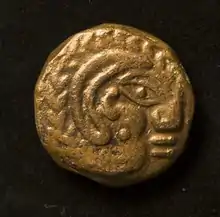Al-Nejd, Sultanate of Oman
Al-Nejd is an archaeological site in Ash Sharqiyah, Oman. It was a fortified village inhabited during the Samad Late Iron Age and possibly during Islamic times. The site was discovered in 2014 following the chance find of a coin by a local resident, and was then confirmed and dated by a team from the Ministry of Heritage and Culture.[1] The site yielded the first tetradrachm of Abiel type, which was struck in what is now the United Arab Emirates. The coin is on display in the National Museum in Muscat.[2]

Photograph of the site

The imported tetradrachm confirmed as from the site
Al-Nejd is fortified, has a garden and is directly near a water course (wadi), all characteristics of the Samad Late Iron Age.[3][4]
References
-
- Paul A. Yule, Valorising the Samad Late Iron Age, Arabian Archaeology and Epigraphy 27/1, 2016, 56‒58 Figs. 16‒19 ISSN 0905-7196.
- Jamal al-Musawi et al., The National Museum Sultanate of Oman Highlights, Muscat, 2016, p. 27 ISBN 978-1-78551-051-9
- Jürgen Schreiber, Transformationsprozesse in Oasensiedlungen Omans. Die vorislamische Zeit am Beispiel von Izki, Nizwa und dem Jebel Akhdar. Dissertation, Munich, 2007, pp. 62-64, URL http://edoc.ub.uni-muenchen.de/7548/1/Schreiber_Juergen.pdf
- Paul A. Yule, Cross-roads – Early and Late Iron Age South-eastern Arabia, Abhandlungen Deutsche Orient-Gesellschaft, vol. 30, Wiesbaden 2014, esp. 62-63 Table 5 (Pros and cons for theoretical premises for the existence of the Samad LIA), ISBN 978-3-447-10127-1, E-Book: ISBN 978-3-447-19287-3
External links
- Photographs from the Heidelberg University image database
This article is issued from Wikipedia. The text is licensed under Creative Commons - Attribution - Sharealike. Additional terms may apply for the media files.